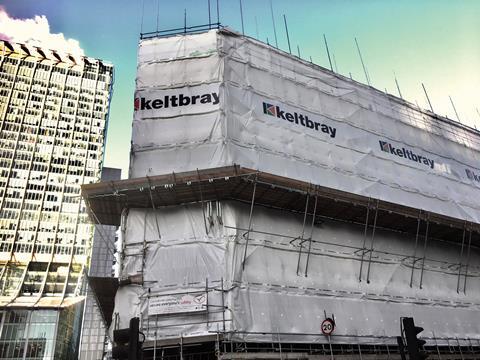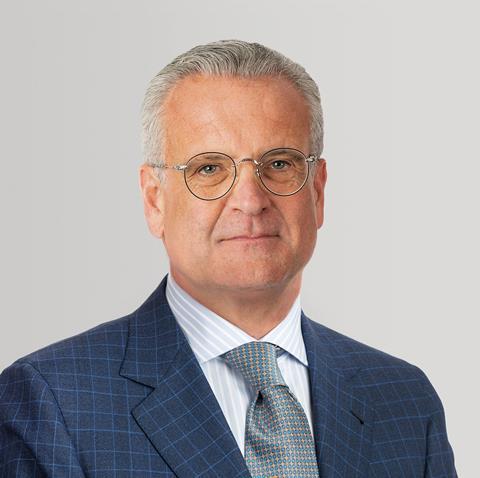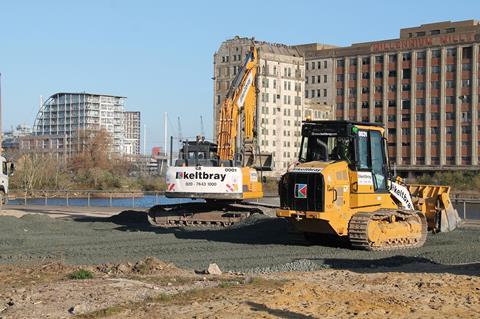After 30 years at Costain, Darren James was unable to resist the call of Keltbray’s Brendan Kerr who brought him into the firm to help it diversify and tighten up governance. So where is the company is headed now?

“It was an odd time to be a new CEO,” concedes Darren James. The 54-year-old is looking back to April Fool’s Day in 2020.
He had just swapped 30 years at Costain to join Keltbray, with his first day in the new post coming on 1 April, a week after Boris Johnson put the country into lockdown to deal with the covid-19 pandemic.
James had been recruited after a call from Keltbray’s owner, Brendan Kerr, the year before. He had only been made chief operating officer at Costain in the spring of 2019 when former chief executive Andrew Wyllie stepped down, but Kerr – who was looking for someone to help grow the business into new markets and tighten up its corporate governance – got in touch nonetheless.
Their paths had crossed before with the pair working together on several jobs, including Costain’s scheme to revamp London Bridge station where Keltbray carried out demolition work, before James eventually traded Maidenhead, where Costain is based, for the Esher, Surrey, headquarters of Keltbray.
“Brendan can be quite persuasive,” says James of the decision to leave his former employer of three decades. His ties with Maidenhead have not been completely cut as he still has a home in the town, living there during the week before returning to his family in his native Swansea, where he has two teenage daughters and a third, aged 22, who has just graduated from Cardiff University.
Darren James CV

1986-90 Completes civil engineering degree at University of Surrey, including industrial placement with Costain from 1988
1990 Joins Costain as graduate trainee
1990-2007 Rises through the ranks at Costain, from site engineer to project director to highways director
2007-19 Managing director of Costain’s infrastructure business
2019 Becomes chief operating officer at Costain
2020 Appointed chief executive of Keltbray
Bethan, his wife of 30 years, works as a matron at the city’s Morriston Hospital. “She’s been a dedicated nurse all her life,” he says. “With covid, she carried on and I carried on.”
Other high-profile executives who have been recruited by Belfast-born Kerr include former Laing O’Rourke boss Tony Douglas, now the chief executive of airline group Etihad and a non-executive since 2010. Sir Robert McAlpine’s former London boss Vince Corrigan joined five years later and is now Keltbray’s COO.

More recent arrivals include Phil Wilbraham, the former head of Heathrow’s third runway expansion, and Ashley Muldoon, now the COO of data centre firm Global Switch and the former chief executive of Multiplex, who both joined as non-executives in November 2020.
James also worked with his fair share of industry luminaries at Costain, which he joined in 1990 after completing his civil engineering degree at Surrey University in Guildford. Part of the course saw him work on the firm’s A55 Conwy Crossing in north Wales on an industrial placement.

His first chief executive was Peter Costain, followed by Alan Lovell, who helped to rescue the business from its mid-1990s abyss, thereby earning himself something of a reputation as a troubleshooter, which led to spells at other struggling firms such as Jarvis and lately Interserve. Then came John Armitt, who went to head up Railtrack and the Olympic Delivery Authority, and Stuart Doughty, like Armitt another graduate of John Laing, and now a non-executive director at Balfour Beatty.
James learnt a lot, he admits, adding: “I’m still in touch with all of them.”
Before becoming Costain’s COO, he spent a dozen years as head of its £1bn infrastructure business which includes the firm’s highways, rail, energy and nuclear work. It was this background that helped to catch Kerr’s eye as he looked to diversify and branch out from Keltbray’s London commercial heartland.
The firm has worked on dozens of high-profile jobs in the capital including the Shard, the redevelopment of Battersea Power Station and a string of towers going up along Bishopsgate in the Square Mile. James says London commercial still accounts for 40% of the business but this has come down from the 60% to 70% that it used to be. Instead, infrastructure has grown to around 45%, with commercial work – which includes the jobs in this sector it does outside the capital – around 55%.
It’s all about unleashing our potential. We have fantastic people and great capability for the markets we are in, and we would like to do that for some new people too
Darren James
Because of the cyclical nature of commercial schemes, the firm needed to build more resilience into the business by expanding the amount of work it does in infrastructure where pipelines of work tend to be longer – attractive to a firm like Keltbray, which operates a self-delivery model and as such needs jobs to keep its 2,000 staff and fleet of plant and equipment busy.

But James cautions: “It would be a mistake to think the London market is not an attractive part of our strategy.” As such, the firm is putting together a report into what future workloads in the sector will look like, with a recent bellwether report from the Chartered Institute of Procurement & Supply saying that confidence in commercial is now at its highest level since last summer as the threat of the Omicron variant wanes and plan B restrictions are lifted.
Of the new strategy, James adds: “It’s all about unleashing our potential. We have fantastic people and great capability for the markets we are in – and we would like to do that for some new people too.”
He says that, after nearly two years in post, his work on tightening up corporate governance is pretty much done. This has included introducing a clear delineation between the main and executive boards, the firm’s first ever business code of conduct which includes compliance training for all employees, and the appointment of non‑executives, including Wilbraham and Muldoon, to achieve FTSE-standards of independent scrutiny.
He stresses that there was nothing particularly wrong with the corporate governance before he joined. “Keltbray had a sophisticated process in place, it didn’t need root and branch reform. Strong corporate governance is about giving confidence to clients and funders. You have to demonstrate you have a strong governance.”
Keltbray’s history
1976 Keltbray is founded
2003 Brendan Kerr, who joined as a junior project manager in 1989 and became group managing director 10 years later, becomes the sole owner and CEO after completing the buyout of the last of the four previous owners’ stakes for £5m, bringing the total purchase price to £7m. He first acquired a share in the business in 1993 with a 20% holding for £35,000
2009 Keltbray sets up its piling arm and moves into the rail market with the acquisition of track maintenance and renewals firm Gamble from administration
2010 Revenue falls by a third to £87m after the recession following the global financial crash sees profit collapse from £5.8m to £210,000
2013 Keltbray Remediation is launched
2016 Keltbray Structures is launched after buying parts of the collapsed concrete firm Dunne from its administrators
2019 Turnover tops £500m figure for the first time, with income of £563.4m
2020 Darren James becomes the first chief executive since Kerr became its sole owner
2021 The firm moves into highways work with a deal to take over road jobs from the collapsed NMCN
Some may have worried that an emphasis on corporate governance would tone down some of Keltbray’s entrepreneurial zeal, which has largely been driven by Kerr and has seen it accelerate its growth strategy – with key acquisitions such as the moves for stricken rail firm Gamble in 2009, another stricken firm, concrete business Dunne, seven years later, and last autumn’s move for parts of collapsed civils and building firm NMCN.
“With a single shareholder, you get a lot of agility over decision-making – which is a very big advantage,” James says. “It’s not about going against Keltbray’s entrepreneurial spirit, it’s about having checks and balances and making it an integrated organisation.”

James has created a two-board structure – the main board, which includes him and Kerr as well as non-executives Douglas, Wilbraham and Muldoon, and a separate executive board.
He says the non-executives give up around four days of their time a month and adds: “The main board sets the strategic direction and holds the executive board to account to make sure they are following the strategy. The executive board is there for the day-to-day running of the business.”
The executive board has been pepped up with a number of new recruits including James’ fellow Welshman Tim Bowen, a former highways director at Costain who joined in May 2020, Michael O’Hagan, like Kerr from Northern Ireland, who arrived the same month from concrete specialist Getjar to head up Keltbray’s built environment business, and group people director Kyla Farmer, who joined in late 2018 from listed food distributor Compass Group.
Other new recruits include Neil Thompson, who arrived from Crossrail last July as its head of rail, and group technical director Craig Moorfield, who joined the following month from Multiplex, while former Alfred McAlpine boss Mike Snee was made boss of the energy arm at the end of 2020. “It’s taken the best part of 18 months but the bulk of [the reorganisation] is done and in place,” James says.
With a single shareholder, you get a lot of agility over decision-making – which is a very big advantage
Darren James
A year ago, Keltbray won its first major roads job with a scheme to build new bridges and structures on the A30 in Cornwall for Costain. It felt like a landmark, James says, with the normally more London-focused Kerr especially pleased. “Brendan is very passionate about where the business has come from,” James adds. “It was a big win.”

It is also bidding with Vinci on a £275m job to build a network control centre and rolling stock maintenance depot for HS2 in Birmingham and is the standout name on the list of firms lined up to upgrade the A66 in northern England where it is rubbing shoulders with more traditional road builders such as Balfour Beatty and Costain.
The A66 job was one of five road schemes Keltbray picked up after it moved for the infrastructure business of collapsed contractor NMCN last October. “I approached the CEO of NMCN and he put me in touch with the administrator,” James says. As well as highways, the firm picked up a pair of civil infrastructure jobs, including a footbridge in Barnsley, South Yorkshire, and some flood alleviation work.

Keltbray is also looking at more nuclear decommissioning work and defence work – for clients the Ministry of Defence and the Atomic Weapons Establishment – while its rail arm, which has been growing in the UK with overhead line work for Network Rail, also works abroad in Australia and Canada, where it is carrying out an electrification contract near Toronto.
The company is due to release its latest set of accounts next month and James says that it will be a return to the black, even though turnover will have slipped to just under £400m, from £428m last time where it also slumped to a £9.4m loss for the period covering the 12 months to October 2020.
The slump into the red was quite a shock, given the firm had posted a record £563m income in 2019 and a £10.5m pre-tax profit. James says turnover will be up and close to the £500m mark for its current financial year, while profit will be up again. Moving forward, he wants margins of 5%, adding Keltbray is looking at double-digit profit growth every year.

Competition for work, especially in the commercial market, is still fierce as clients have sat on jobs to ride out the uncertainty caused by the pandemic. “We’re not chasing work; we do most of our work two-stage or negotiated,” he says, echoing the findings of a recent report by Aecom which said tier 1 and tier 2 contractors in London were eschewing fixed-price jobs because of worries about spiralling wages and the cost of materials.
A turnover figure of £900m and staff numbers of 3,000 are not out of the question by 2026, he adds. Would it, then, be fair to call it a tier 1 contractor or is it still a tier 2? “In rail, energy and highways we’re definitely a tier 1,” James says. “In other areas, we’re a tier 2. I’d say overall we’re a tier one-and-a-half.”



























No comments yet